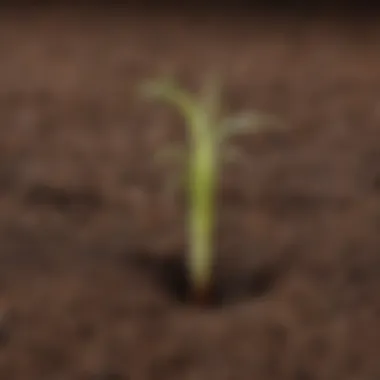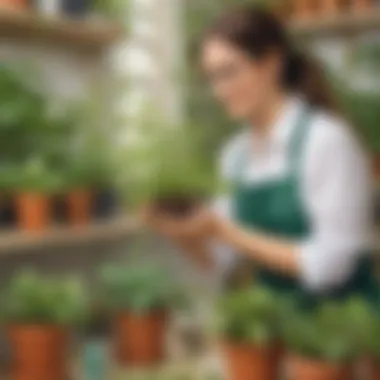Exploring Plant Growth: Engaging Activities for Young Science Enthusiasts


Science Fun Facts
In the world of plants, did you know that the largest flower is the Rafflesia arnoldii, which can grow up to three feet in diameter? This incredible flower emits a scent similar to rotting flesh to attract insects for pollination. How fascinating is nature's way of ensuring the survival of plant species!
Discover the Wonders of Science
As we embark on a journey from seed to plant, let's delve into the fascinating realm of photosynthesis. Discover how plants use sunlight to convert carbon dioxide and water into glucose, their source of energy. Learn about the essential role of leaves in this process and how they serve as nature's solar panels, capturing light for the miraculous transformation within plants.
Science Quiz Time
Are you ready for a seed to plant quiz challenge? Test your knowledge on the life cycle of plants, from germination to seed dispersal. Can you identify the stages of plant growth and understand the importance of each phase? Put your botanical skills to the test with fun multiple-choice questions and brain teasers that will spark curiosity and deepen your understanding of plant biology.
Science Experiment Showcase
Get your lab coats ready for some exciting plant experiments! Explore the effects of different variables on plant growth, from light and water to soil types. Follow step-by-step instructions to set up your plant experiment, gather your materials list including pots, seeds, and measuring tools. Remember to prioritize safety with precautions such as wearing gloves and goggles to ensure a safe and successful scientific exploration.
Introduction
Exploring the Fascinating World of Plants
Importance of Plants in Our Ecosystem
Plants play a vital role in sustaining life on Earth. Their ability to produce oxygen, provide food, and create habitats for various organisms underscores their significance in our ecosystem. Understanding the importance of plants in our ecosystem is crucial for appreciating the interconnectedness of all living beings.
Curiosity Sparked by Plant Growth
The journey of a seed sprouting into a full-fledged plant sparks curiosity and wonder among individuals. This natural process of growth and development fascinates not only young minds but individuals of all ages. Observing plant growth instills a sense of awe and appreciation for the beauty of nature.
Educational Value of Learning About Plant Life Cycle
Learning about the plant life cycle offers numerous educational benefits. It helps individuals grasp fundamental biological concepts such as germination, pollination, and photosynthesis. Exploring the plant life cycle educates young science enthusiasts about the intricate mechanisms that govern life forms around us.


Overview of From Seed to Plant Activities
Significance of Understanding Plant Growth
Understanding plant growth is essential for nurturing a deeper connection with nature. By comprehending the stages of a plant's life cycle, individuals can appreciate the care and effort required for plant cultivation. This knowledge fosters a sense of responsibility towards the environment.
Interactive Learning Approach for Young Minds
Engaging young minds through interactive plant activities enhances their learning experience. Hands-on experiments and visual aids make complex biological processes more accessible to children. This interactive learning approach cultivates a sense of discovery and encourages active participation in scientific exploration.
Seed Germination
Seed germination plays a pivotal role in the plant life cycle, making it a crucial subject in our discourse on plant activities. Understanding the essence of seed germination aids in unraveling the mysteries of how plants begin their journey from a seed to a full-grown organism. By comprehending seed germination, young minds can grasp the fundamental principles underpinning plant growth. This section will elucidate the intricacies of seed germination, shedding light on its significance in the broader context of plant development.
Understanding the Germination Process
Conditions Required for Seed Germination
The conditions required for seed germination are multifaceted and encompass various environmental factors. Factors such as adequate moisture, optimal temperature, and access to oxygen are essential for the successful germination of seeds. Moisture enables the seed to swell and initiate metabolic processes critical for growth, while the right temperature triggers enzymatic activity necessary for germination. Additionally, oxygen is crucial for respiration during germination, ensuring the seed receives the energy needed to sprout. Understanding these conditions is vital as it dictates the success or failure of the germination process. Properly meeting these requirements sets the stage for healthy plant growth, making it a fundamental aspect of the plant life cycle.
Stages of Germination
The stages of seed germination follow a systematic progression, starting with the absorption of water by the seed. This initial phase leads to the seed swelling and softening, preparing it for the emergence of the radicle, the embryonic root. Subsequently, the radicle elongates, anchoring the seedling in the soil and allowing for the growth of the shoot towards the light source. As the shoot emerges, it develops into the first leaves of the plant, marking the transition from a dormant seed to an actively growing seedling. Understanding the stages of germination provides young enthusiasts with insights into the miraculous transformation seeds undergo to become thriving plants.
Hands-On Seed Germination Activities
Seed Sprouting Experiment
The seed sprouting experiment is a hands-on activity that allows young learners to witness the magic of germination firsthand. By providing seeds, water, and a conducive environment, children can observe the seedling emerge from the seed, showcasing the various stages of germination. This experiential activity not only reinforces theoretical knowledge but also cultivates a sense of wonder and excitement for the natural world. Through the seed sprouting experiment, children can actively engage with the germination process, fostering a deeper connection with plant growth and development.
Germination Observation Journal


The germination observation journal serves as a tool for documenting the germination process over time. Children can record daily observations, noting changes in the seeds as they sprout and grow into seedlings. This activity not only enhances scientific observation skills but also encourages patience and diligence in observing natural phenomena. The germination observation journal allows young minds to appreciate the gradual progression of seed growth, instilling a sense of responsibility towards caring for living organisms. By maintaining a record of the germination process, children can track the growth of their plants, creating a personal connection to the cycle of life and nurturing a love for nature.
Plant Growth and Development
Plant growth is a fundamental aspect of understanding the lifecycle of plants. In this article, we delve deep into the various stages of a plant's development, aiming to provide young science enthusiasts with a detailed insight into the process. By exploring the intricacies of plant growth, we can appreciate the remarkable transformations that take place in the natural world.
Life Cycle of Plants
Seedling Stage
The seedling stage marks the initial growth phase of a plant, where the seed germinates and transforms into a young plant. This stage is crucial as it signifies the beginning of the plant's journey towards maturity. Seedlings are delicate and require special care to ensure healthy development. Understanding the seedling stage is essential for young learners to grasp the significance of nurturing plants from their early stages.
Mature Plant Growth
Mature plant growth represents the pinnacle of a plant's development, showcasing its full potential in terms of size, structure, and reproductive capabilities. This stage is vital in sustaining the plant species and plays a key role in ecosystem dynamics. Observing mature plants provides valuable insights into the complexities of the natural world and underscores the importance of environmental conservation.
Reproduction Phase
The reproduction phase is a critical stage in the plant life cycle, where plants produce seeds or spores to ensure the continuation of their species. This phase highlights the ingenuity of plant reproduction mechanisms and the diversity of strategies employed by different plant species. Exploring the reproduction phase offers young learners a deeper appreciation for the ingenious ways in which plants ensure their survival and propagation.
Interactive Plant Growth Activities
Incorporating interactive plant growth activities enhances the learning experience for young science enthusiasts, making the process engaging and immersive.
Plant Growth Tracking Chart
A plant growth tracking chart allows children to monitor and record the growth of their plants over time, providing visual cues to track progress. This activity fosters a sense of responsibility and curiosity as young learners observe the subtle changes that occur during plant growth. It also encourages them to actively participate in the nurturing process, promoting hands-on learning and scientific inquiry.
Role-Play: Plant Life Cycle
Engaging in role-play activities centered around the plant life cycle enables children to embody different stages of plant growth and reproduction. By assuming roles such as seeds, seedlings, and mature plants, young learners can gain a holistic understanding of the plant life cycle. Role-play enhances communication skills, creativity, and critical thinking as children simulate real-life processes in a fun and educational context.


Plant Care and Maintenance
In the realm of young science enthusiasts, caring for plants is a vital aspect that cannot be overlooked. Plant care and maintenance play a pivotal role in nurturing a love for nature and instilling responsibility in children. By understanding the significance of maintaining plant health, youngsters can grasp the essential connection between humans and the environment. The consideration of plant care provides a gateway to appreciate the delicate balance existing in ecosystems, sparking curiosity and empathy towards the natural world.
Ensuring Healthy Plant Growth
Watering and Sunlight Requirements
Watering and sunlight requirements stand as fundamental elements in the realm of plant care and maintenance. The proper balance of water and sunlight ensures optimal growth and development of plants. Water acts as a crucial carrier of nutrients and facilitates important physiological processes like photosynthesis, while sunlight serves as the primary energy source for plant growth. Understanding the unique needs of each plant species regarding watering frequency and light exposure is critical to maintaining their well-being. Too much or too little of either can lead to detrimental effects such as dehydration or sunburn, emphasizing the importance of striking a harmonious balance in plant care routines.
Nutrient Needs of Plants
Nutrient requirements constitute another essential aspect of plant care and maintenance. Plants depend on a range of nutrients, including nitrogen, phosphorus, and potassium, to thrive. These essential nutrients play key roles in various plant functions such as photosynthesis, root development, and disease resistance. By providing plants with the necessary nutrients through proper fertilization and soil management, young enthusiasts can promote strong and healthy growth. Understanding the specific requirements of different plant species ensures that their nutrient needs are adequately met, enhancing overall vitality and resilience.
Engaging Plant Care Activities
DIY Plant Pot Decoration
Engaging in do-it-yourself (DIY) plant pot decoration activities adds a creative and personalized touch to plant care routines. Decorating plant pots not only enhances the aesthetic appeal of indoor and outdoor spaces but also encourages a sense of ownership and attachment to plants. Young learners can explore their artistic talents by painting, accessorizing, or repurposing containers to create unique vessels for their green companions. This hands-on activity cultivates a deeper connection with nature and fosters a sense of pride in caring for plants, promoting creativity and environmental stewardship.
Creating a Plant Care Schedule
Establishing a plant care schedule is a practical and effective way to ensure consistent and comprehensive maintenance of plants. By creating a structured routine for watering, pruning, and monitoring plant health, young enthusiasts develop valuable organization and time management skills. A care schedule not only helps in tracking and addressing the specific needs of each plant but also instills discipline and responsibility in tending to living organisms. Through the establishment of a systematic care plan, children learn about the importance of commitment and diligence in nurturing and supporting plant life, fostering a sense of accountability and respect for the environment.
Conclusion
In concluding this comprehensive guide on From Seed to Plant Activities for Young Science Enthusiasts, it is vital to recognize the pivotal role of plant-related engagements in nurturing a profound appreciation for nature. By immersing oneself in the various stages of plant growth, individuals develop a deeper understanding of the intricate processes underscoring ecosystem dynamics. This not only fosters curiosity but also instills valuable lessons on the interconnectedness of all living organisms, highlighting the importance of plant life in sustaining our environment. Moreover, through hands-on experiences with plants, young learners cultivate essential scientific skills, such as observation, critical thinking, and experimentation, laying a solid foundation for future academic pursuits and environmental stewardship.
Cultivating a Love for Nature Through Plant Activities
Impact of Hands-On Plant Experiences
Delving into the realm of Impact of Hands-On Plant Experiences unveils a transformative facet of educational engagement that resonates deeply within the core of this article. The inherent value of hands-on experiences lies in their ability to transcend traditional learning boundaries, offering young enthusiasts an experiential journey into the wonders of plant growth. By actively participating in activities like seed germination, plant care, and growth monitoring, children not only witness scientific concepts come to life but also develop a profound connection with nature. The tactile nature of hands-on experiences fosters sensory exploration, enabling learners to internalize abstract theories and principles in a tangible and memorable manner. Furthermore, by encouraging active involvement and experimentation, hands-on plant activities spark creativity, resilience, and a sense of accomplishment, shaping young minds into inquisitive and environmentally conscious individuals.
Encouraging Environmental Stewardship
Within the overarching theme of Encouraging Environmental Stewardship lies a crucial aspect of promoting sustainable practices and ethical responsibility among young learners. Environmental stewardship emphasizes the significance of preserving and protecting our natural surroundings, instilling a sense of duty towards environmental conservation and biodiversity conservation. By engaging in plant activities that focus on sustainable practices, such as recycling, composting, and water conservation, children learn firsthand the impact of their actions on the environment. This hands-on approach not only fosters ecological awareness but also nurtures a sense of ownership and responsibility, empowering youth to become proactive stewards of our planet. Through cultivating a deep-seated respect for nature and instilling conservation values early on, Encouraging Environmental Stewardship lays the foundation for a generation of environmentally conscious citizens committed to safeguarding our planet for future generations.







